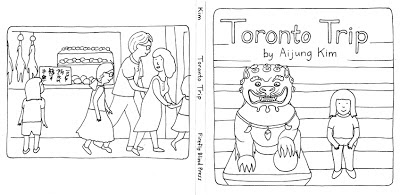Below are my finished plates. Some are colored differently than others depending on what color cardstock I had on hand, and some have been printed already so contain some ink residue on the surface. Making the plates is simple but does require time, planning, and some gusto with the razor blade and scissors. After planning out your image, take a piece of cardstock and start cutting your design. Glue the pieces to another piece of cardstock. I like to use a different color for my backing cardstock to contrast the cut-out designs that I glue onto it so it's easier to see. Then I apply a coat of acrylic medium on the front and back sides to seal everything nicely so it's easier for me to keep re-using the plates. But you don't have to seal it.
I decided to combine an art-making opportunity with collagraphs. I will be in the upcoming book "Mail Me Art: Short and Sweet," as part of the Mail Me Art project. Each participating artist had to create an envelope with the back side decorated and send it to England through the post. It's a bit faint, but you can see that I measured lines that will be folded to make the envelope. I also composed my cut-out shapes and traced a light outline so I knew where I was going to place each shape when I was ready to print.
I used a cardstock stencil and rolled up ink directly onto the paper to create some background color for my shapes. This is a technique I was inspired to do by one of my collagraph workshop participants, Sarah Watson!
And here are the finished background colors. For some of them I didn't use a stencil, but just used my brayer to apply color in the outlines I had drawn.
Next I inked up all my collagraph shapes. By the way, I figured out the right colors after a few hours of experimentation. Here is my messy workspace!
And the inked up shapes. The moon is a lovely silver color.
I placed my printing paper onto the etching press, and then arranged the shapes on top of my paper.
Here are the back sides of the shapes. They have blue ink all over the edges because... well, you'll see why. I used these shapes several times so they have lots of ink residue on them. Notice that my rabbit is right up against the paper, and the house sits on top. This way, the rabbit's paw printed fully, and the house printed in the background. I ran the shapes through the etching press so the ink transfers onto the paper.
After the shapes are printed, I leave them on top of the paper *suspense!* There is another step I want to add: I take my brayer and roll blue ink around the outside of the shapes onto the paper. I like the texture they make.
Here it is after I've brayed all around my image area. I used the edge of my brayer carefully against the sides of the cardboard shapes to get very close.
And now, the moment has arrived: I pull the cardstock shapes away and VOILA! A magical rabbit leaping to the moon. Only the middle part of this image will be seen on the envelope, which is why I didn't bother coloring the entire thing.
And here are three other variations that I made on the way to getting this one image just right! There were even more of them than I'm showing here.
I will write about the creation of the Mail Me Art envelope in another post. Hope you've enjoyed this one!














+039.JPG)
+040.JPG)
+042.JPG)
+043.JPG)
+046.JPG)
+050.JPG)
+052.JPG)
+054.JPG)



